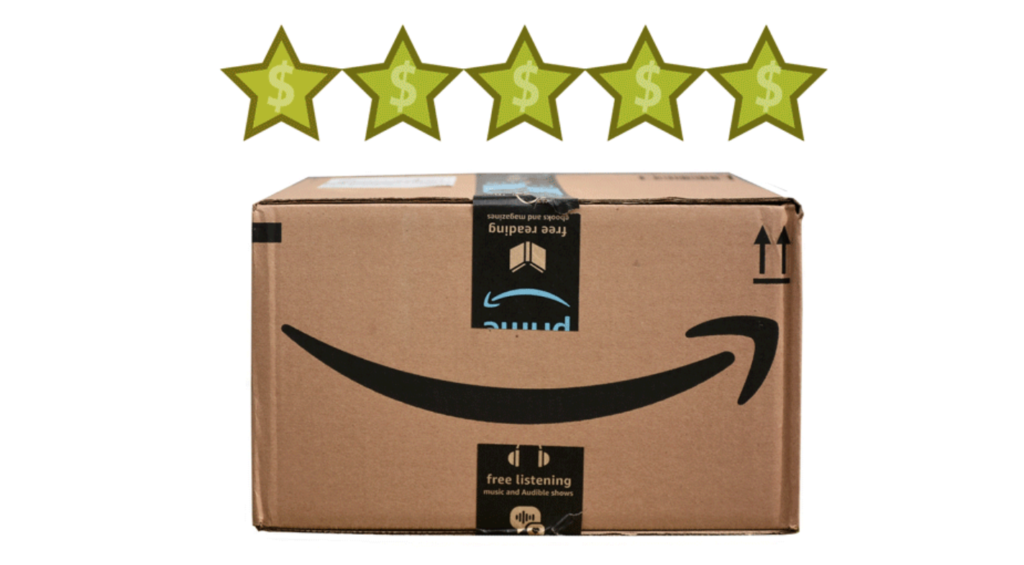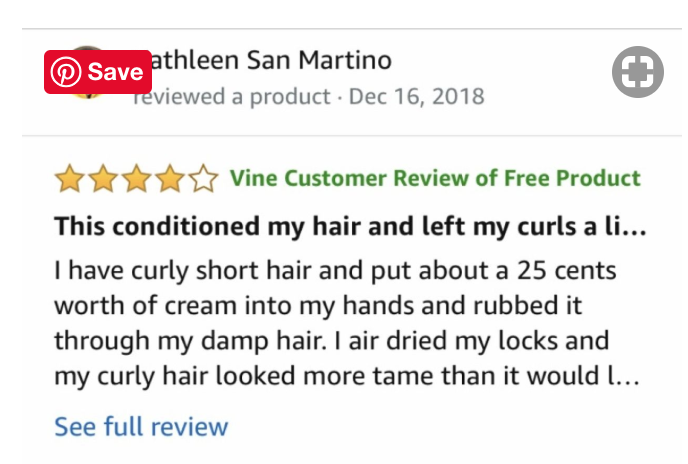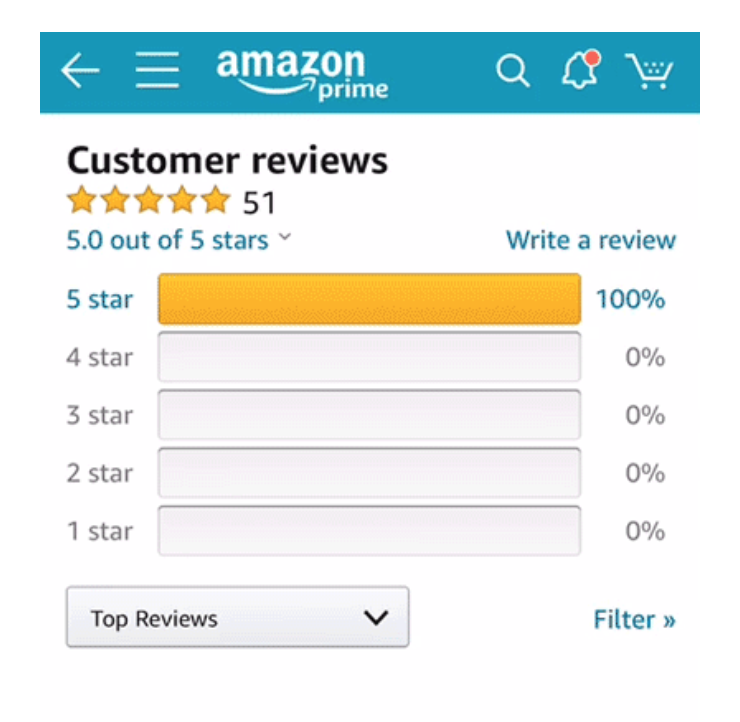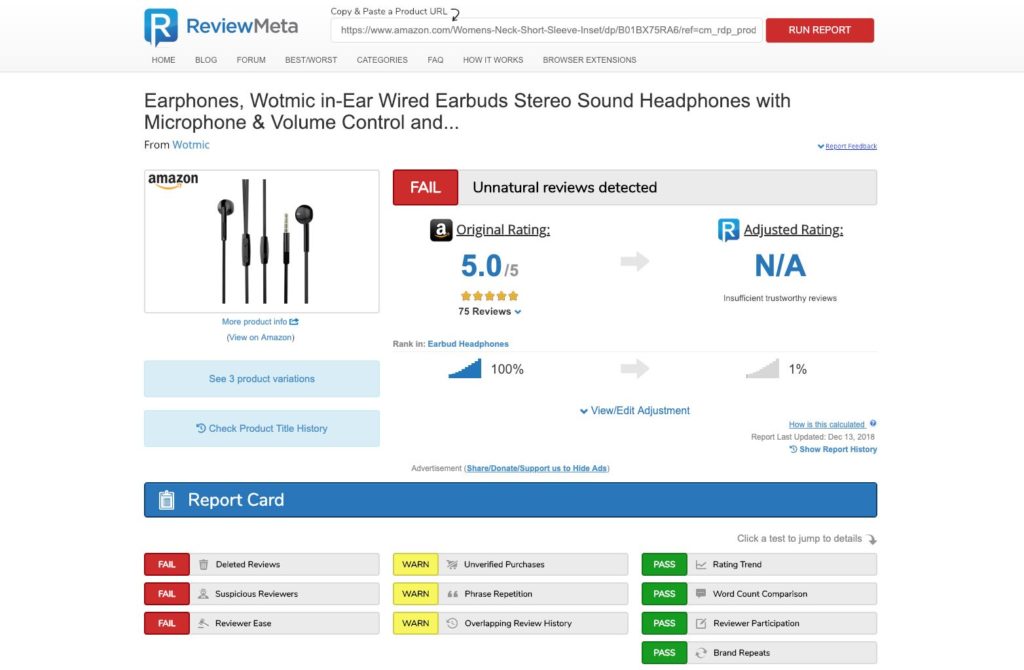Is It Really Five Stars? How To Spot Fake Amazon Reviews (#GotBitcoin?)
It’s on us to understand how Amazon reviews really work before we buy, and it’s on Amazon to start rethinking the star system entirely. Is It Really Five Stars? How To Spot Fake Amazon Reviews
Dogs Love Water!!!

My dog loves this pet drinking fountain. He doesn’t care that it’s louder than Niagara Falls when the water level is low, and that the setup instructions were impossible to follow. Oops, this is supposed to be a positive review. So, yeah, the LED light is nice, I guess?
I’ll never actually post that, but it could have been worth money if I had. Let me explain. I visited a Facebook group called “Amazon Reviews” and was promised a full refund on a $44 Amazon purchase of a pet fountain if I did the following on the mega-retailer’s site:
- Write A Positive Review.
- Post My Photos of The Product.
- Rate It Five Stars.
Not only is this ethically problematic, it is also against Amazon and Facebook user policies. Plenty of people don’t care, though: They’ll do it for this pet gizmo or one of the other bajillion products in these forums.
Every day, many of us search for a product on Amazon, pick a four- to five-star option and tap Buy Now. Those little yellow stars can make or break a product.
“In early 2012, the Amazon catalog grew too big, and the only way to get to the top of search results was to prove to the algorithm that your product was the best,” said Juozas Kaziukėnas, chief executive of Marketplace Pulse, a business-intelligence firm focused on e-commerce. “Most sellers realized acquiring reviews was a golden ticket.”

Over the past few years, Amazon has cracked down on fake reviews as well as on incentivized reviews, where companies offer refunds to shoppers in exchange for top stars. However, my hours lurking in shady Facebook groups and combing Amazon reviews tell me both types are very much still alive and well.
It’s on us to better understand the complicated world of Amazon reviews before we make a purchase. But it’s on Amazon to start rethinking the star system entirely.
The Types of Reviews
There are four species of Amazon review:
A Legit Review. Left by a human who bought a product and felt like sharing, the legit review, often labeled as a “Verified Purchase,” might be peppered with real-life experiences that indicate genuine use.
Legit reviewers tend to be moved to review when they love or hate the product, so the ratings are more extreme, says Tommy Noonan, founder of ReviewMeta, a website that analyzes Amazon reviews.

Kathleen San Martino Is An Amazon Vine Member. Vine Reviews Have This Green Label.
A Vine Review. Amazon invites some of the most prolific legit reviewers to be a part of Vine. The program rewards them with free products in exchange for reviews, marked with a green label. Vine members choose from a preselected group of products, but neither Amazon nor the company that provides the product can influence, edit or modify reviews, Amazon says.
Amazon Vine reviewers I interviewed say they don’t let the perk influence their ratings, and showed me many negative reviews they have written. ReviewMeta found Vine reviewers give more two-, three- and four-star reviews than other groups.
“I write reviews because this is a way for me to have a voice—on the garbage products and the great products,” said Kathleen San Martino, of Morris County, New Jersey. She has reviewed approximately 1,500—I repeat, 1,500—products on Amazon over the years. (To see her in my video, click here.)
Vine reviewers do pay something: The products’ value is considered taxable income.
An incentivized review. Incentivized reviewers are given free products—or in some cases flat-out payments—in exchange for four or five stars. In 2016 Amazon updated its terms of service to prohibit this practice, but sellers found a big back alley: Facebook.

On Dec. 14, A Listing For A Pair Of Wotmic Earphones Received Dozens Of Five-Star Ratings. By Dec. 18, Amazon Had Removed Them All.
Here’s How It Works: A shopper joins a Facebook group with a name like “Amazon reviews.” These groups tend to be private but I was let into two, even after saying I was a journalist.
Sellers, often out of China, post about free products, say Bluetooth headphones. The buyer gets the Amazon link from the seller via direct message, orders the headphones through Amazon so it can appear as a “Verified Purchase,” then writes the review, posts some photos and rates it five stars. Once proof of purchase is provided, the seller refunds the buyer, generally via PayPal .
The moderator of one of the Facebook product-review groups I joined directed me to his rules, which state that members are meant to write honest, unbiased reviews, and that the group isn’t responsible for “deceitful posts or dishonest reviews left by buyers/sellers.” Facebook says it closes groups that offer incentives for fake reviews. Amazon says it works with Facebook to police these groups.
I spoke with various reviewers in these groups, many of whom didn’t want to be identified. They say they write these types of reviews to save money.
THE SHADY SIDE
Some categories on Amazon draw the most questionable, potentially fake product reviews, according to ReviewMeta. Here are 10 of the most targeted categories:
- Earbud Headphones
- Screen Protectors
- Weight-Loss Supplements
- Hair-Loss Products
- Baby Monitors
- Testosterone Boosters
- Streaming Media Players
- Phone Charging Cables
- Diaper Bags
- MP3 And MP4 Players
“I definitely gave a 4- or 5-star review to stuff that wasn’t good,” said Jeffrey Chu, from Charlotte, N.C., who reviewed products from Facebook groups until Amazon blocked him from reviewing last year. “I felt a little bit bad about doing it, but even before this, I noticed a lot of BS reviews. I figured the system was broken, I figured I’d get stuff out of it.”
The fake review. Finally, there are the full-on fakes. These reviews don’t show verified purchases and consistently deliver high ratings without much detail. One person I saw on Craigslist offers reviews starting at $5 a pop. So-called click farms in Asia claim to control thousands of Amazon accounts that vendors can hire to leave reviews for between $1 and $5 each.
Sellers also “hijack” legit reviews through some back-end trickery, Mr. Noonan said. A merchant might put a new item on the page of a well-reviewed but now-unavailable older product. The star rating looks good, but the reviews don’t match the item.
Fighting Back
Amazon is on high alert right now, cracking down on scams and fake reviews and deleting thousands of suspect reviews.
“We suspend, ban or pursue legal action against these bad actors as well as suppress all known inauthentic reviews,” an Amazon spokeswoman said. “Customers can report suspicious reviews 24 hours a day, seven days a week and we investigate each claim.”
Last week, I spotted a listing for headphones branded Wotmic with 51 five-star ratings—and no poorer ratings. This week, Amazon’s sweep removed all 51 reviews. Wotmic’s parent company, Shenzhen Womaisi Technology Co., Ltd. hasn’t responded to repeated requests for comment.
Another page I found featured a teeth whitener with an apparent average 4.5-star rating. However, many of the written reviews pertained to fish oil, cinnamon tablets and other health products. When I reached out, the vendor, AsaVea, didn’t respond—but soon all but the relevant reviews disappeared. (Negative reviews complaining about the apparent review hijacking also remained.) The product is now rated three stars.
Many dubious reviews still slip past the sentries, so we all have to follow three steps:
Step 1: Skip Stars. Read The Text.
Even just skimming the written reviews section will allow you to spot red flags. Be on the lookout for potential product swaps, or for a bunch of generic-sounding five-star reviews posted on the same date. Click on reviewers to see what else they’ve written.
Step 2: Try A Review Rating Site.
ReviewMeta and Fakespot automatically look for those red flags and more. Paste in an Amazon product page address, and either site gives you a review of the reviews. They both calculate the average star rating with questionable reviews removed. I prefer ReviewMeta for its more comprehensive report cards.

Step 3: Take Everything With A Grain of Salt.
Don’t believe everything you read. Amazon says it gives more weight to reviews deemed helpful by shoppers, but many star ratings might still be artificially inflated.
After all my reporting, my conclusion is that the star system itself is the culprit. I’m not the first to reach this conclusion: Netflix moved to a thumbs-up/thumbs-down system with more personalized recommendations after acknowledging star problems.
I’m not sure how Amazon would adapt that sort of system, but certainly one of the world’s most valuable companies, with more than 600,000 employees and a major investment in artificial intelligence, can try to figure it out. Hopefully before we all buy two-star pet fountains masquerading as five-star ones.
Updated: 10-19-2020
Amazon Fake Reviews Reach Holiday Season Levels During Pandemic
Fake reviews on Amazon.com Inc. during the pandemic have reached levels typically seen during the holiday shopping season.
About 42% of 720 million Amazon reviews assessed by the monitoring service Fakespot Inc. from March through September were unreliable, up from about 36% for the same period last year. The rise in fake reviews corresponded with the stampede online of millions of virus-avoiding shoppers.
“We’ve only seen those kinds of numbers in the Black Friday or Christmas period in 2019,” said Fakespot founder and Chief Executive Officer Saoud Khalifah. “In 2020, the surge of fake reviews has proliferated in a rapid manner coinciding with lockdown measures in the USA.” By contrast, almost 36% of Walmart.com reviews assessed by Fakespot during the same period were fake — about the same as last year.
Bogus reviews have plagued Amazon and other online marketplaces for years, despite the companies’ efforts to purge them. The perpetrators, sometimes paid, either hype the virtues of a product or sabotage it to tank sales. Various automated services have emerged to help shoppers assess whether the reviews they’re reading are real.
Fakespot, which monitors reviews on Amazon and Walmart Inc.’s site, awards grades to product write-ups. A D means 40% to 70% of reviews for a given listing are fake; an F alerts users that more than 70% are suspect. The company says more than 20 million users have used Fakespot since its 2015 debut — a testament to how much shoppers rely on reviews and ratings to choose which products to buy.
“Companies like Fakespot and ReviewMeta that claim to ‘check’ reviews cannot concretely determine the authenticity of a review, as they do not have access to Amazon’s propriety data such as reviewer, seller and product history,” an Amazon spokeswoman said in an email. She added that the company is aware of “bad actors” attempting to abuse the system and is investing “significant resources to protect the integrity of our reviews.”
Khalifah said his firm picked up a rise in unreliable reviews as Covid-19 spread across the U.S. earlier this year and demand for hand sanitizer, masks and other protective equipment spiked.
One listing for a face mask was rated 3.9 stars, mostly by members of Amazon’s Vine reviewing program, which invites its “most trusted reviewers” to post opinions about new and pre-released items. One of the reviewers claimed to have assessed nine products that day and 1,348 in total. To Fakespot, that was a classic tell.
“No one has time to review that many products ever,” Khalifah said. “These are obviously fake.” He said that though he believes Amazon conducted a purge in September, the number of unreliable reviews found by Fakespot remained the highest the company has recorded.
ReviewMeta, which focuses on Amazon, says it also noticed an increase in the number of unreliable reviews this summer compared with last year. But founder Tommy Noonan doesn’t entirely attribute the increase to the pandemic-fueled surge in online shopping. Rather he blames new features introduced by Amazon to make it easier to review products.
“There are so many things going on in Amazon,” Noonan says. “There are so many little loopholes that can affect the fluctuations we see.”
He cites One Tap Reviews, which let users rate products from one to five stars without commenting. Before this feature was rolled out, users had to leave a written review describing the product, which included their profile information and a time stamp. Without those two identifying details, Noonan says, it has become more difficult to discern whether the star ratings are real.
He suspects the changes have helped push up the average rating on One Tap reviews to about 4.6 stars, compared with 4.3 stars when reviewers had to comment on, as well as rate, a product. “This has already led to abuse,” he wrote in a blog post from February and updated in July. “We can’t see the dates the ratings were submitted, which users submitted the ratings, what other products those users rated.”
“One Tap review was created to help shoppers get authentic customer ratings on products from a broader set of customers who we know have experienced the product,” the Amazon spokeswoman said. “Customers can help other shoppers even if they aren’t willing to write a detailed review, by simply giving the product a star rating.”
Based on past experience, Khalifah expects the volume of fake reviews to worsen as Amazon heads into the holiday shopping season, which will be busier than usual as shoppers continue to avoid stores amid an uptick in Covid-19 cases. “If it’s too good to be true,” he says, “it probably isn’t.”
Updated: 6-13-2021
Fake Reviews And Inflated Ratings Are Still A Problem For Amazon
Sellers are taking advantage of the online-shopping frenzy, using old and new methods to boost ratings on products.
A charging brick recently caught my eye on Amazon. AMZN -0.08% It was a RAVPower-branded two-port fast charger, and it had five stars with over 9,800 ratings. The score seemed suspect but Amazon itself was the seller, so I added it to my cart anyway.
The device arrived a day later, along with a clue to all that customer satisfaction. A small orange insert offered a $35 gift card—roughly half of the product’s price—with instructions on how to redeem the gift: “Email us A. Your order ID (screenshot) B. Your review URL (or screenshot).”
Since the fast-charging tech is new to the market, “We want to see how people like it,” said Donny Dong, vice president of sales at Sunvalley, the parent of RAVPower. He said the company didn’t force customers to leave five stars in order to claim a gift card.
An Amazon spokesman said the insert violates the company’s policy, which bans sellers from offering a financial reward for reviews.
Gift-card rewards are a common approach employed by sellers—even, in the case of RAVPower, Amazon’s wholesale vendors—to entice customers to rate products. They are also a reminder of how difficult it is for Amazon to police the manipulation of reviews, even on products it sells directly. The purchases are genuine, and the compensation is coordinated through email, out of Amazon’s view.
Since the beginning of the pandemic, Amazon says it has added 50 million Prime members and made profits of over $26 billion, more than the previous three years combined. As Amazon purchases increased, so did review manipulation.
Sellers are taking advantage of the online shopping frenzy, using new methods to bolster ratings on products ranging from cordless vacuums to toilet-paper holders. For shoppers, this can mean diminished overall trust and frustration, as they try to pick a winner from a crowded field of low-quality, no-name “five star” items, mostly from China.
The Amazon spokesman said the company analyzes 10 million reviews a month, using a combination of human moderators and machine-learning tools to stop abuse. “We will continue to innovate to ensure customers can trust that every review on Amazon is authentic and relevant,” he said.
Amazon recently made changes to its listings, such as adding one-tap ratings and including scores from around the world. While the intent was to increase the quantity of legitimate ratings, these changes can make it harder for shoppers to tell authentic reviews from inauthentic ones.
Flooding The Zone
“The number of ratings I’ve seen on products has skyrocketed,” said Tommy Noonan, founder of ReviewMeta, a website that analyzes Amazon reviews. “Amazon is trying to jack the number of ratings up as high as they can to instill consumer confidence.”
In other words, flooding the zone with legitimate reviews could technically drown out the fakes. One-tap ratings, launched in the fall of 2019, allow customers to submit a star rating without accompanying text.
The problem? “You can’t see the customer’s reasoning, or determine whether it might be a paid review,” Mr. Noonan said. He found instances of potential manipulation: One pair of earbuds had over 5,000 five-star ratings and zero written reviews.
The Amazon spokesman said the feature allows a broader set of customers a way to leave feedback more easily. Customers can add more-detailed feedback at any time, he said.
In early 2020, Amazon began including global ratings, which appear lower down the page and feature reviews from countries such as Canada, the United Kingdom and Japan. While the reviews might be legitimate, I found multiple listings with ratings for completely different products.
A $46 USB flash drive included U.K. reviews for a screen protector, and a $20 digital meat thermometer with over 2,000 ratings featured reviews for “plasters”—British for bandages. One listing for hair clippers had amassed over 23,000 ratings, including reviews, in French and German, for a TV mount.
After I shared the listings with Amazon, the company removed the offending ratings and the number of reviews plunged. (The thermometer lost all but four of its customer ratings.)
“When we identify pages with abusive grouping, we take the appropriate enforcement actions and use these learnings to improve our proactive mechanisms,” the company spokesman said. He said customers are encouraged to use the “Report abuse” link, available on each review, if they are concerned about manipulation.
“We think this is the worst move for consumers ever,” said Saoud Khalifah, chief executive of Fakespot, a website that evaluates the authenticity of product reviews on online stores including Amazon, Best Buy and Walmart. Not only do global ratings allow for irrelevant, recycled reviews, even the products themselves might be dissimilar. “A coffee machine might have a completely different set of features in the U.S. versus the U.K.,” he said.
Same Old Tricks
Despite Amazon’s continuing efforts to fight the fakes, old ways to manipulate reviews still abound too. People post images of sellers’ products on Facebook groups and review sites.
To qualify for a rebate, reviewers pick a product to buy and follow instructions intended to boost a product’s ranking. (For example: When reviewing a USB microphone, search “computer microphones” and then click the specific product from the search results.) The kickback isn’t handled through Amazon, of course, but through PayPal or some other service.
In April, following a U.K. investigation, Facebook removed 16,000 groups related to facilitating fake reviews. “We proactively work with social-media sites to report bad actors who are cultivating abusive reviews outside our store,” the Amazon spokesman said. Still, a quick search on Facebook yields dozens of active review groups, some with thousands of members. “We don’t want this type of activity on Facebook and are working to improve our enforcement,” a Facebook spokeswoman said.
Some sellers track down customers who leave negative feedback on listings. Last December, Ben Hendin of Tulsa, Okla., gave two stars to an unsatisfactory finger brace.
The seller sent multiple messages to his personal email, escalating monetary incentives to delete the review, from $10 to finally $40. Amazon doesn’t give sellers customer email addresses. When Mr. Hendin asked how the seller got his, the reply read, “Boss found it through social software search for names.”
Mr. Hendin reported the seller to Amazon customer service, but never heard a response.
Temporary Gains
A study from the University of California, Los Angeles, and the University of Southern California that was published last August tracked 1,500 products on Amazon with reviews solicited from Facebook groups. The researchers found that sellers continue to juice their listings with paid-for reviews because the benefit wears off after about a month—when unhappy purchasers start countering the high scores with low ratings—and because Amazon’s algorithms appear to put more weight on recent reviews.
The researchers said Amazon eventually did take action—purging roughly a third of the observed fake reviews about 100 days, on average, after they appeared. The Amazon spokesman rebutted the finding, but didn’t say why.
“Deletion after a lag like that is inadequate,” said Brett Hollenbeck, the study’s co-author and an assistant professor of marketing at UCLA. “Sellers still find it profitable, and consumers still feel harmed by buying these products.”
Sellers tend to prop up reviews more aggressively around shopping holidays such as Prime Day and Black Friday, said Fakespot’s Mr. Khalifah. His analysis shows that Amazon steps up its enforcement around these occasions, deleting large numbers of reviews that it likely considers to be fraudulent.
One strategy to avoid buying low-quality products is to rely on brand names. But established companies are becoming rarer breeds on the platform. The owner of Birkenstock pulled its products from the site in 2016, saying Amazon wasn’t doing enough to police knockoffs.
Nike stopped selling directly on Amazon in 2019; at the time, people familiar with the matter told The Wall Street Journal that Nike officials were disappointed Amazon didn’t eliminate counterfeits and gray-market goods. Amazon’s own private-label business, which competes directly with such brands, is under legislative scrutiny.
Meanwhile, Amazon’s sales grow, and market share increases. Even Prof. Hollenbeck acknowledged that he occasionally buys products he knows are propped up by fake reviews. “How bad can an $8 night light be?” he asked.
Is It Really Five,Is It Really Five,Is It Really Five,Is It Really Five,Is It Really Five,Is It Really Five,Is It Really Five,
Related Articles:
These Companies Are Succeeding Despite Amazon Or A Slowing Economy (#GotBitcoin?)
Venmo And Amazon Hit By Breaches And Fraudsters (#GotBitcoin?)
Amazon, Amid Crackdown on Seller Scams, Fires Employees Over Data Leak (#GotBitcoin?)
Amazon Targets Unprofitable Items, With a Sharper Focus on the Bottom Line (#GotBitcoin?)

Leave a Reply
You must be logged in to post a comment.